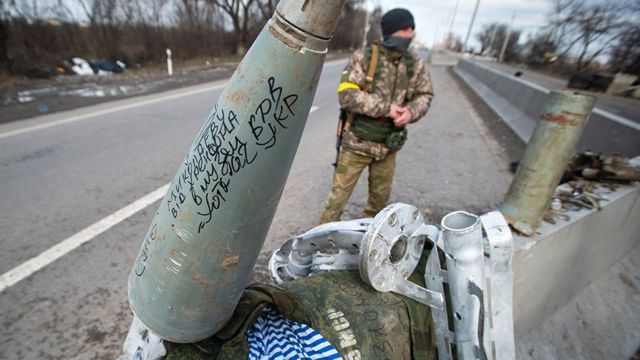Harsha Kakar
A recent announcement from the White House mentioned that the US is despatching cluster bombs to Ukraine. In an interview to CNN television, President Biden stated that it had taken him ‘a while to be convinced,’ adding, ‘the Ukrainians are running out of ammunition.’ A Cluster bomb, on exploding, releases smaller bomblets which kill indiscriminately over a wide area. Casualties are higher if used in built up areas. The ammunition is controversial as some released bomblets fail to explode. The US also claims that Ukraine had requested for this ammunition.
Unexploded bomblets can remain in situ for years and then indiscriminately explode causing civilian casualties. As per Human Rights Watch there have been between 56,500 to 86,500 civilian deaths from unexploded cluster ammunition since 1943, when it was first introduced. 123 nations are signatory to a convention banning cluster ammunition, introduced in 2008, and almost 90% stocks of cluster bombs held by these nations destroyed. The US, Russia and Ukraine are not signatories to the agreement and continue to maintain stockpiles.
Currently both Russia and Ukraine use them. Ukrainians possess Turkey manufactured cluster bombs. As per the UN, 10 to 40% of the bomblets, currently being used in the conflict, have failed to detonate and akin to mines,may explode later due to human contact. The US defended its decision of sending these bombs to Ukraine by stating that they will be employed only on their soil and hence not expand the conflict. Human Rights groups and the Red Cross have condemned the US decision.
The US National Security Advisor, Jake Sullivan, in a press conference mentioned that the cluster bombs being sent to Ukraine failed far less frequently than those being fired by Russia. UK, New Zealand, Spain and Canada, all US allies,have protested the decision. While most nations objected being signatories to the convention, the New Zealand PM, Chris Hipkins, stated they were, ‘indiscriminate, they cause huge damage to innocent people, potentially, and they can have a long-lasting effect as well.’
The US National Security spokesperson, John Kirby, defended likely civilian casualties occurring due to employment of this ammunition, by stating, ‘I think we can all agree that more civilians have been and will continue to be killed by Russian forces — whether it’s cluster munitions, drones, missile attacks or just frontal assaults.’ He added that Ukrainian forces are depleting their supplied ammunition at a rate of ‘many thousands of rounds per day.’
There are multiple reasons as to why the US is adopting this drastic measure, ignoring global criticism. Firstly, it is aware that Ukraine is losing the war, despite the Russian Private Military Company, Wagner, being out of reckoning for the present. Kiev’s much hyped counter offensive has almost stalled, opening doors for Russia to launch its next offensive.
Ukraine’ space of expending ammunition is a cause of concern. With ammunition being provided by donors, Ukrainians have no control on their rate of fire. John Kirby mentioned, ‘We are trying to ramp up our production of the kind of artillery shells that they’re using most. But that production rate is still not where we wanted it to be.’
Secondly, with US elections due at the end of the year, the possibility of a Republican, may be Trump, entering the White House looms large. They are unlikely to support the war at the same level as Biden has done, resulting in Ukraine and ultimately NATO suffering a major setback. Trump has made his position on the war very clear. A change of guard in the White House will also impact support being provided by other NATO members, as without US funding, they alone will not be able to sustain Ukraine’s military requirements.
Most important is the state of availability of ammunition in the US, levels of which are maintained based on nature of threat. As stored ammunition reaches its shelf life and fresh supplies are received, these are rotated and expended in training. In the current case, majority of the ammunition rotated is being sent to Ukraine. This implies that ammunition reaching Ukraine comes from US reserve stocks and includes those nearing the end of their shelf life.
Fresh production, not matching quantities of ammunition being exported,has probably led to depletion of US stocks to critical levels. This would be unacceptable to the US military as future conflicts remain unpredictable. In such a scenario, alternate options would have been considered and cluster ammunition earmarked.
The US has provided Ukraine with 155mm Howitzers from its stocks. These howitzers fire cluster bombs. The US was already holding quantities of cluster ammunition and would in some time frame have to destroy them to meet global pressures. Sending them to Ukraine would be an easier option as also could financially be included as part of the aid package. Casualties to Ukrainian civilians are a result of utilization of this ammunition would not impact the US in the long term. More importantly, it could help stem a future Russian offensive by imposing caution as unexploded bomblets act like anti-personnel mines.
No nation would ever provide recently produced stocks of ammunition to a beneficiary. Nor would a nation accept depleted stocks of its war reserves. Peace time production levels are always low and aimed at meeting normal contingencies. Production is only ramped up when threats are imminent. Hence, the supply of cluster bombs to Ukraine is not with an intention of boosting its military power but because the US was compelled by circumstances. The question is whether the US should be accused of war crimes due to civilian casualties on account of use of cluster bombs.
No matter how the US justifies its actions, the reality is that it has been compelled by circumstances to adopt this measure. This, in no way, justifies civilian casualties which may accrue due to its decision.
The author is Major General (Retd)
Trending Now
E-Paper


